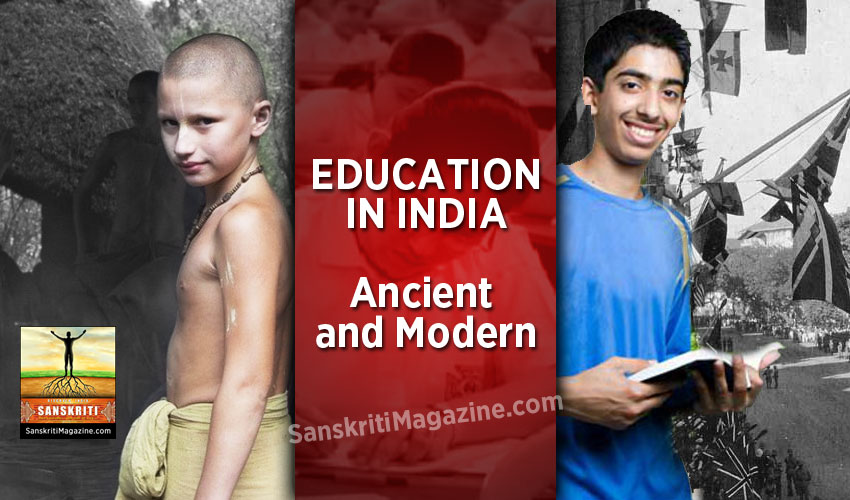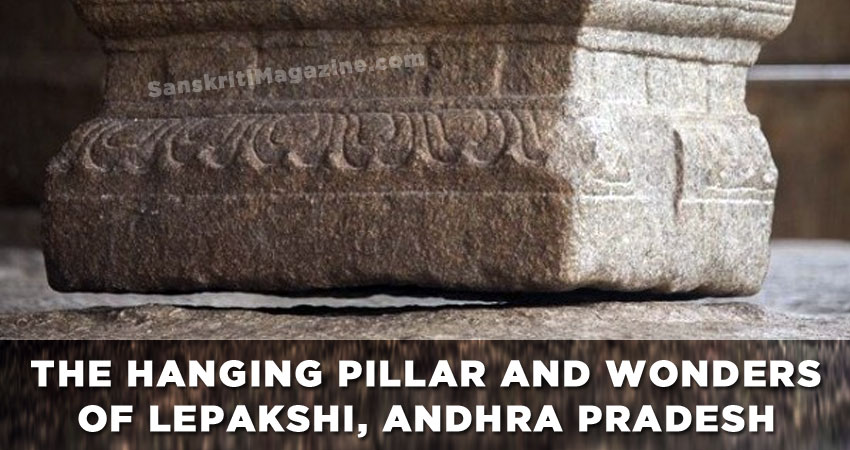‘Neti’, ‘Neti’ meaning “learning is a never-ending process and the sources of knowledge are countless.”
In India, illiteracy of a large number of people has turned the visions of “Education for All” into empty dreams. Especially, population explosion has put a heavy pressure on its available infra-structure. According to 2011 census, literacy-rate has gone only upto 74% from 65%. For males it has risen to 82% from 75%, for females to 65% from 54%. About 20% of its population is still illiterate. In absolute number, the figure of illiterates is alarming. No nation can afford to have a large number of its population to remain illiterate, ignorant and unskilled.
Education and the masses
In ancient India, education was confined within a very small section of Indian society. It was not so much because of discrimination that a large number of common people were debarred or denied access to education, as it was due to the following reasons:
- Method to educate – In the past, because of the method of education, education remained confined within a very small section of the society. In absence of any written material, priestly schools in India had devised a most remarkable and effective system of transferring knowledge to succeeding generations in form of hymns. They restricted it only to those, who possessed brilliant feats of memory and capability to keep its extreme sanctity.
- Use of Symbolic language – Symbolic language was in use to express thoughts, customs and institutions. The purpose was perhaps to make it easier for the human mind to remember. It gave everything in the society a sacrament, religious and sacrosanct, but not in a narrow sense. Shiva -Shakti stood for Divine masculine-feminine union, four elements of nature – Om stood for the sound of creation, Trishul for trinity, Lotus for balance, Venus star for creativity, Sacrifice for an offering to gods, Purush and prakriti for ideal man-woman relationship, Somras as a symbol of divine bliss etc. In Upanishads, Hindu epics and Geeta, there are many examples of symbolic mentality. Later on, this trend gave everything an imaginative, mysterious, mystic or divine shape.
- Modern society has lost the mindset to understand the true meaning of this symbolic language and is being criticized vehemently by some sections of society such as Purush-Sukta of Veda says that four parts of chaturvrna have been born from the body of the Creative Deity, from his head, arms, thighs and feet. These are symbolic expressions. It expresses a divine reality. Its sense is that Brahmans were men of knowledge, kshatriyas the men of power, Vaishyas the producer and Shudras the service persons supporting the other three.
- Neti-Neti – There was infinite scope of development. Nothing was supposed to be final. Neti-Neti was the principle for quest of knowledge.
- Masses remained away from formal education, even when everything was put together in the epics – “Vedas”, “Smritis”, “Sutras”, and “Upanishads”, because of the medium being Sanskrit.
- Masses were busy in their hereditary/traditional occupations. Skills were learnt more on job under the training and guidance of people already on the job/occupation. For attaining more skills or furthering their future prospects masses did not depend on formal education, certificates/degrees/diplomas or on formal centres of education and training i.e. schools/colleges.
- The manner, in which hereditary occupational knowledge and skills were transferred, was through practice and experience; not through formal classroom lectures, which often kills originality and verve of people. The system led society to have more production, economic efficiency and specialization in various areas of activities like spinning, weaving, pottery making, bead making, seal making, terra-cotta, handicrafts, brick-laying, metal work etc.
- But still, illiterate masses got the benefit of the knowledge of learned sages and munies. On the basis of their scholarly researches and experiences, the sages prescribed certain guidelines in the form of rituals to be followed by common men.
Education in Ancient India
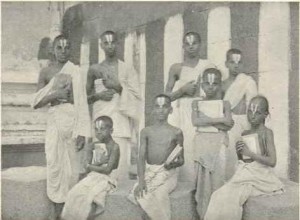 Education a private concern – Education in ancient India was a private concern. Occasional grants were given from the state, private charitable institutions and pupils. The tutor supplemented his income by performing professional duties of the priest.
Education a private concern – Education in ancient India was a private concern. Occasional grants were given from the state, private charitable institutions and pupils. The tutor supplemented his income by performing professional duties of the priest.
Educational institutions of repute
Many travellers among whom most famous are Magasthenes (a Greek ambassador who arrived at Patliputra in 302 BC), Fa-hien, Hiuen Tsang and I-Tsang threw much light on Indian values and systems. Holy places like Taxila, Ayodhya, Banaras, Amaravati, Mathura, Nasik or Kanchi and capitals of kingdoms like Patilputra, Valabhi, Ujjayani and Padmavati were famous centers of education. Valabhi in Gujarat and Vikramshila in Bihar were famous centers of learning. In south India centers of learning were known as Ghatikas. Most famous centers of learning were the monastic colleges mostly founded by Budhists. Students flocked from all places.
Few of most important universities of ancient India were Taxila (being the first university of world established in Seventh century B.C.), Vikramshila University and Nalanda University (built in 4 A.D). Huan Tsang in his records mentioned the University of Taxila to be at par with Nalanda and Vikramshila Universities. These institutions were considered to be the best Universities of their times in the subcontinent and an honour to ancient Indian educational system.
Takshila University was famous for medical studies. Varanasi was famous for religious teachings. In the South, Kanchi was famous for its studies while the Vallabhi University was no less. There was a galaxy of eminent teachers like Panini- well known grammerian, Kautilya – the minister of Chandragupta Maurya and Charaka – a medical teacher of repute.
Nalanda University – Nalanda was the epitome of such centers. It attracted students not just from India, but also from the entire South Asia. It was an international University. Scholars of different castes, creeds, and races hailing from India, China, Japan, Korea, Java, Sumatra, Tibet, Mongolia and Bokhara came here for higher/advanced studies. The teachers often attracted students from far and wide. It had eight colleges, one of it having four storied building and around 10,000 students and teachers on its roll cards. It was one of the earliest examples of residential cum learning complex. Technical education was usually imparted in the family itself, as most of the professions were hereditary. Sometimes artisans took students as apprentices.
Steps to pass on knowledge – Knowledge was passed on orally from one generation to another in ancient India. Education involved three basic processes:
- Which included ‘Sravana‘ (stage of acquiring knowledge of ‘Shrutis‘ by listening).
- ‘Manana’ (meaning pupils to think, analyse themselves about what they heard, assimilate the lessons taught by their teacher and make their own inferences,) and
- ‘Nidhyasana’ (meaning comprehension of truth and apply/use it into real life).
Method – Students were taught particular texts at home of teacher. It was learnt by rote, enunciation and pronunciation were particularly taken care of. Students were supposed to lead a strictly regulated life. Aims of learning were faith, retention of knowledge, progeny, wealth, longevity and immortality. Besides domestic schools there were specialised agencies, discussions or conferences arranged by the kings. Women freely participated in these conferences. There were Parishads for advanced studies. There were wandering scholars, Chaarakas, who spread education in the country.
Education and women
 Women enjoyed freedom, respect and honour. According to Manu “where women are honoured, the gods rejoice, where they are not respected, all actions become futile.”
Women enjoyed freedom, respect and honour. According to Manu “where women are honoured, the gods rejoice, where they are not respected, all actions become futile.”
In ancient India women were given equal right to education and teaching. Women seers like ‘Gayetri’ or ‘Maitreyi’ were prominent participants in educational debates and proceedings of ‘Parishads’ (Assemblies). It was mostly the Brahmins followed by Kshatriyas that received education at the gurukuls, while boys from the lower castes learnt their family trade from their fathers.
No bar
Individuals from humblest origin were highly educated and were respected in Indian society as great achievers. Vashishtha, the principal of conservative school of Brahmanism, was the son of Uravshi, a prostitute. Vishwamitra, the quintessence of Vedic Brahmanism and maker of Gayatri Mantra, was a Kshatriya. Aitreya, after whom sacramental part of Rig-Veda is named as Aitreya Brahamana, was the son from a non-Aryan wife of a Brahman sage. Vyasa of Mahabharata fame was the son of a fish-woman. Balmiki, an untouchable according to present standards and the original author of Ramayana, is highly respected all over India.
“An ocean of knowledge in a jar”
Ancient Indian philosophy and Vedic literature contained “an ocean of knowledge in a jar.” It was supposed to be a magnificent example of scientific division and orderly arrangement of rules, in a few words, in different branches of human knowledge, covering almost all the aspects of life, be it phonetics, arts, literature, medicine, polity, metrics, law, philosophy, astrology or astronomy. It spoke of everything- on staying healthy, social evils, improving concentration and tenets of behavior, which are relevant even today.
“Rituals”
The substance of the knowlegde, learning and research work of Rishis-Munis (sages and saints) was put in the form of rituals for the benefit of common-men. Certain practices/guidelines were shaped in the form of rituals by intellectuals and prescribed for the benefit of commom men. These rituals and guidelines inspired people to lead a harmonious and healthy life.
Spot out gems
With a rational mind, raising it from ignorance, one can understand the greatness of Vedic literature. A knowledgeable person can spot gems from this ocean of knowledge; pick them up and leave like worthless pebbles the undesired, obsolete elements developed into the system with passage of time.
Revival of ancient knowledge
During second half of the nineteenth and beginning of the twentieth century, Swami Vivekanand, Rama Krishna Mission and Theosophical Society of India tried to familiarize the Western World, too, to the charm and graciousness of the ancient gold mine of knowledge, which had inspired not only Indians, but foreigners as well. Intellectuals from various countries have translated it in their own languages and reinterpreted it for a rational mind. As India progressed from ancient to medieval, its education system deteriorated. Medieval age began with Rajput culture and ended with Indo-Muslim contacts. Society was marked as conventional society. The grip of conventionalism weakened the society and led to darkness, corruption, anarchy and failure. Various factors were responsible for the degradation of such an efficient and most ancient education system of the world.
Modern education before Independence
Modern education system
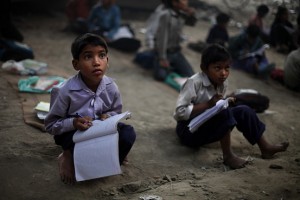 Modern education system was implanted by British rulers. Before the advent of British in India, education system was a private one. In 1835, Lord Macauley introduced modern education in India. It was the introduction of Wood‘s dispatch of 1854, known as Magna Carta of Indian education that laid the foundation of present system of education and changed the scenario. The main purpose of it was to prepare Indian Clerks for running local administration. Under it the means of school educations were vernacular languages, while the higher education was granted in English only. British government started giving funds to indigenous schools in need of help and slowly some of the schools became government aided.
Modern education system was implanted by British rulers. Before the advent of British in India, education system was a private one. In 1835, Lord Macauley introduced modern education in India. It was the introduction of Wood‘s dispatch of 1854, known as Magna Carta of Indian education that laid the foundation of present system of education and changed the scenario. The main purpose of it was to prepare Indian Clerks for running local administration. Under it the means of school educations were vernacular languages, while the higher education was granted in English only. British government started giving funds to indigenous schools in need of help and slowly some of the schools became government aided.
Reasons for introducing modern education
Finding it too costly and perhaps practically impossible to import enough Englishmen to man the large and increasing number of subordinate or lower posts in administration, British rulers planned of educating Indians in such a way that they “should through western education get Anglicised in terms of both cultural and intellectual attainments”. Lord Macauley clearly said that, “we must at present do our best to form a class, who may be interpreters between us and the millions whom we govern; a class of persons, Indians in blood and colour, but English in taste, in opinions, in morals and in intellect.”
Welcoming modern education
The atmosphere was completely ready for Lord Macauley to lay the foundation of modern education in India by 1835. Missionaries and their supporters as well as National leaders, intellectuals and Reformers not only welcomed but exerted pressure on the company to encourage and promote western education in India. Missionaries believed that modern education would lead the people to adopt Christianity. Humanitarians, intellectuals and nationalist leaders considered modern education “the key to the treasures of scientific and democratic thought of the modern West” and the best remedy for social, political and economic ills of the country.
Outcome of modern education
In 1844 through a Declaration knowledge of English was made compulsory for Government employment. The traditional Indian system of education gradually withered away for the lack of official support. The government made English medium schools very popular. English as Official language alienated the masses from the educated Indians. Because of modern education and new employment opportunities, many traditional occupations became obsolete. In near absence of industrial, commercial or social service activity, people in India were forced to depend on modern education and Government jobs for their respectful earning. Modernisation of occupations and industrialisation processes increased role of formal education and training for furthering future prospects of people.
The universities at Calcutta, Bombay and Madras were started in 1837 and higher education spread rapidly thereafter. For scientific and technical education, only three Medical Colleges one each at Calcutta, Bombay and Madras was established by 1857. There was only one good engineering college at Roorkee.
National leaders, intellectuals and reformers
Modern education not only produced persons to fill the lower levels of administration, as desired by the rulers, but also produced national leaders, intellectuals and reformers like Raja Ram Mohan Roy, Dadabhai Naoroji, Ferozeshah Mehta, Gokhale, Gandhi, Jinnah, Ambedkar, Tilak, Lala Lajpat Rai, Moti Lal Nehru, Jawahar Lal Nehru, Subhash Chandra Bose, Patel and many more. They took upon themselves the responsibility to build a modern, open, plural, culturally rich, prosperous and powerful India out of a fragmented, poverty stricken, superstitious, weak, indifferent, backward and inward looking society. In short, they believed that:
- Western literature and philosophy would give Indians the understanding of liberal, scientific, democratic and humanitarian ideas thought of Western World.
- It would make Indians aware of the real issues hampering the progress of Indian society.
- Modern education would improve the life of common men and conquer ignorance, hunger, poverty and disease.
- It would open the key to the treasures of Scientific and Democratic thought of Western World.
- Principles of Democracy would spread rapidly across the nation and finish imperialism and tyranny.
- It would remedy many social, political and economic ills of the nation.
Brahmins ahead of others
Initially, it was an impoverished group of Brahmin and caste Hindus in search of livelihood, who desire to live with dignity and honor opted for modern education. Gradual displacement from their source of income after decline in financial status of their patrons – Princes and Zamindars, appalling poverty of Brahmins compelled them to opt for modern education.
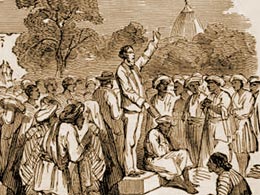 Reason being their poverty, not discrimination
Reason being their poverty, not discrimination
Sir Alfred Croft, Director of Public Instruction in Bengal wrote to Rev. J. Johnston in 1881, “We know well that any considerable increase in the fees paid by college students would compel many to withdraw. It seems not to be fully understood… how poor the middle classes that flock to our colleges really are. Half the students live from hand to mouth…. And yet though, far behind in point of wealth, they correspond to, and are in fact the only representative of our professional classes at home, and the pressure on them for the means of subsistence is so great, that they must either be educated or go to wall.”
Their poverty gets confirmed by a study done to examine the annual income of the guarantors of 1271 Brahmin Students enrolled at Ferguson College, Pune from 1885 to 1895. According to it, 76% of the Chitpavan Brahmins guarantors belonged to the low or medium income groups. Similarly of the 277 Deshastha Brahmin guarantors, 70% came from low or medium groups.
They being natural learners and pursuers of knowledge utilized new type of employment opportunities created with introduction of modern education in 1835. They were quick and far ahead of other communities to grasp almost all the opportunities in these spheres. Their long tradition and undisputed role in the field of knowledge and learning, their intelligence, sincerity and hard work helped them even after independence to secure important places in the modern society.
Why masses deprived of modern education
Except for a few, masses could not avail the advantage of formal modern education. Relentless effort of missionaries and reformers could educate a very small number of people. Reasons being:
- Modern education was very costly and, therefore, unaffordable by the masses.
- Masses did not see any immediate use of education. It was more important for them to work and arrange two square meals day.
- The emphasis was on English medium education system.
Served double purpose
Introduction of modern education had served adouble purpose for the British rulers – they got the credit for the amelioration of the Indian society. But at the same time, through it, they devised a unique method of distribution of power, kept balance of power and prolonged their rule in India by keeping the natives busy in their in-fights.
Impact of modern education
The second half of the nineteenth century saw the impact of modern education on the minds of Indians as under:
- Christian missionaries brainwashed many people especially the poor by preaching and educating them and developed in their minds a complex about the primitiveness of Indian society, influenced them towards the alien culture and then converted them into Christianity. With the help of British rulers, Christian missionaries and religious minded Westerners like William Webberforce or Charles Grant, they succeeded in converting many persons into Christianity.
- National leaders, social reformers, educated people and intellectuals welcomed rationality and other good features of Modern English education. They also got alarmed at divisive policies of the rulers. It led them to lead the national movement. They understood the real issues hampering the progress of Indian society. These organizations had purely an economic and social thrust. They fought against social evils caused by ignorance, superstitions or irrationality like untouchability and inhuman treatment to women, Sati, Polygamy, child marriage, and many others prevalent at that time. Emphasis was laid on education and science. They criticized the mumbo-jumbo of rituals and superstitions created by some selfish people to entangle the ignorant and poor masses.
- Reformers got alarmed at the erosion of Indian Culture. Organizations (like Brahma Samaj founded by Raja Ram Mohan Roy (1828) in Bengal, Prarthana Samaj in Maharashtra (1867), Arya Samaj (1875) founded by Swami Dayanand in Northern India, Rama Krishna Mission, Theosophical Society of India (1879), Dev Samaj in Lahore and Servants of India society) interpreted religion rationally and advised people to remain firmly rooted to the Indian Culture and not get swayed away by the glamour and materialism of alien culture.
- “Back to Vedas” – Therefore, they organized people, held conferences, published articles and undertook internal reform efforts through Sanskritization. They gave a call for “Back to Vedas” and advised people to set free Hinduism from all degenerate features. It was not the Hindu principles, but the practices, which went wrong. Vivekanand said, ‘It is we, who are responsible for our degeneration.‘
Divisible policies of the rulers
Many national leaders and intellectuals got alarmed at the divisible policies of the rulers. They realized the impact of British racial discrimination in the areas of education and jobs and their repressive policies elsewhere. They realized the impact of British racial discrimination. Economic loot, political subjugation, assertion of lordly superiority over the subject on the ground of race, assumption of a haughty exclusiveness, persistent insulting and supercilious behavior towards all Indians, exclusion of Indians from all places of authority and responsibility and denial of their capacity for self-governance united Indians against British rule. The destructive character of repressive policies of British rulers lit the fire and gave birth to national movement.
After Independence
After independence, even relentless effort of reformers, government and NGO‘s only a small could educate a very small number of people especially from amongst backwards. Masses could not avail the benefit of modern/formal education. It is not so much because of resistance from caste Hindus, as for other reasons.
Reasons for not succeeding in “educating all”
It is falsely accused and propagated by some intellectuals, leaders, reformers and supporters of Reservation/Affirmative Action Policy that privileged upper castes have taken advantage of modern education to establish or reinforce its traditional dominance. They prevented lower castes from getting educated or promoting their status in modern society. However, as modern history points out, on the contrary, it was mainly impoverished group amongst Brahmin and caste Hindus opting for modern education, who were in search of livelihood.
Impoverished group
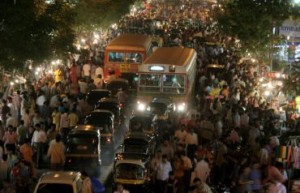 Impoverished group of caste Hindus looked upon modern education as means to earn their living respectfully. Therefore, when modern education was introduced, they, opted for costly Western Education and devoted their scarce resources on it.
Impoverished group of caste Hindus looked upon modern education as means to earn their living respectfully. Therefore, when modern education was introduced, they, opted for costly Western Education and devoted their scarce resources on it.
Costly nature – General masses have not still availed the benefit of modern education. Reasons for illiteracy of a large number of people are many. Quality education is still very costly for common men and, therefore, unaffordable for masses. Costly nature has tended to make it a monopoly of the richer classes and city dwellers.
Population explosion – Population explosion has put a heavy pressure on available. There has been insufficient infrastructure. There is lack of quality education and training systems in government or government aided institutions. Masses do not see any immediate use of education. It still is more important for the poor people to work and arrange two square meals a day.
Importance of English language in modern world
With the changed scenario due to globalization, liberalisation and revolution in Information Technology, English has been accepted internationally as a means of communication. Therefore, learning English language has become necessary to get a space in international world. Education through foreign medium is a difficult task. Earlier English medium had already put undue strain upon the nerves of the Indian students.
Alienation of masses
The language of majority of people is Hindi. However, stress on English medium education and English language is more than it was before independence. After Hindi, English language is being spoken especially by educated Indians, mostly belonging to upper echelons of the society. Increasing importance of English has alienated further the masses from educated ones.
Short-comings of present education system
There are some deficiencies in the present Education system, some of which have been inherited from the British. There are many internal as well as external many pressures on the system, because of which quality of education suffers.
External pressures – Externally, recent social changes and larger political turmoil have affected adversely the whole atmosphere. Some changes took place in the recent past in the character, role and inter-relationship of the six main constituent of the national elites – the political executive, the legislators, the businessmen, the organised workers, the surplus farmers and the bureaucrats. Narrow loyalties, sectional interests and sub-cultures like favouritism, nepotism and corruption have fast become an accepted way of life.
Result is that communal, regional and caste conflicts and unhealthy competition between different sections for power and pelf are increasing every day. Powerful lobbies desire to have exclusive hold on scarce resources of the nation. Few persons and groups, who have the power in their hands and who control almost every walk of national life are working to deny justice to common men. The reflection of all these social evils is found in the educational system as well.
Internal pressures – Based on colonised British Grammar School type education has made Indian students crammer, imitators and unfit them for original work and thought. It has not taught them to have pride in their surroundings. The more they get, the farther they are removed from their surroundings and at the end of their education, they become estranged from their surroundings. They are losing their natural character, because they are getting away from their traditional aspirations and values in preference to the western materialism. Alienation of modern generations from their roots and culture alarmed Gandhiji and he said, My real education began after I had forgotten all that I had learned at School”.
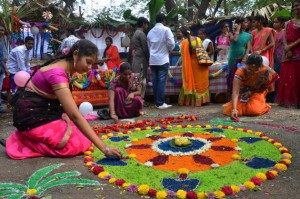 Erosion of Indian culture – Modern education has been disassociating Indian people from their traditional way of learning, classical roots and knowledge. With it have faded Indian values, philosophies and traditions, which had taught Indians the spirit of tolerance and firm belief in the principle, “Live and let live” has always been the part of Indian ethos. Indians believe in “Vasudhaiva Kutumbakam” – the whole world is one family.
Erosion of Indian culture – Modern education has been disassociating Indian people from their traditional way of learning, classical roots and knowledge. With it have faded Indian values, philosophies and traditions, which had taught Indians the spirit of tolerance and firm belief in the principle, “Live and let live” has always been the part of Indian ethos. Indians believe in “Vasudhaiva Kutumbakam” – the whole world is one family.
Rajgopalachari had said, “If there is honesty in India today, any hospitality, any charity — any aversion to evil, any love to be good, it is due to whatever remains of the old faith and the old culture”. Tolerance, truth, Ahimsa, peace and non-aggression are the hallmark of Indian culture.
What should be the limit of tolerance – The people in India endure injustice and unfairness until they are pushed right upto the wall. Many times in the past, Indians had accepted oppression and exploitation without much protest, while such situations would have led to bloody revolutions elsewhere in the world. Even today, the people are tolerating the corruption, scams, scandals and criminal activities developed in political sphere, as well as inefficiency seeped deeply in administration without much protest. People need to be taught not to tolerate injustice and raise their voice against it peacefully.
Influence of West
Present education system has given rise to a group of Indian intelligentsia which is influenced in a big way by social, political, economic norms of western world and their way of living. It vehemently denounce culture, character and social value system of India. It regards the culture of the land as indefensible, responsible for creating many discriminatory social values. The number of such people is increasing. The more its number of such persons grows, especially amongst Indian intelligentsia, the more intolerant, people would become.
Influence on modern youth
A drastic change is visible in the values, behavior and etiquette of a new educated neo- rich youth of elitist class, which has emerged especially in Metros. Their life style and value system are being gradually replaced by the Western ones. They want to enjoy pleasures of modern life at any cost without any restriction. They are more conscious of their rights and want to enjoy life fully in any possible way without any bondage. They do not like any restriction/comment on their behavior or way of life. Loosening grip of social bondage and observances have made many of them selfish, self-willed and arrogant. Some of them have become so intolerant and aggressive, that they out-rightly discard all social norms and etiquette.
Their thinking and value systems are quite different from the older ones. Most of them generally regard Indian value system as rubbish and its epics as irrelevant. They set their own rules. Their yardstick of smartness is interest in stock exchanges, glamour, pubs, parties, discos or late night culture, which gives rise to many kinds of social problems. With growing cult of materialism and consumerism, finer values of life are disappearing fast. Lust for material gains, comforts, craze for luxurious and glamorous life style has made them so insensitive that they hardly feel anything about the hardships and agonies of the “have-nots”. Friendship/relationship prospers only if these cost-effective. Otherwise people do not hesitate in showing their helplessness due to lack of time or energy. The persons, who readily help people in need are considered fools in modern society.
Objective of education?
 Gaining mere knowledge is not the purpose of learning. As Khalil Gibran has said, a little knowledge that acts is worth more than much knowledge that is inactive. Also, one whose knowledge is confined to books cannot use his knowledge wealth when the need for them arises. Knowledge, the object of knowledge and application of the knowledge – all the three are equally important for motivating to take a wise action. Pursuit of material success is super-most objective in the minds of young students. It is making them more and more selfish and intolerant to others. They are drifting almost rudderless without sense of direction. Academic background, career and good earning is important in life for happiness and satisfaction, but more important is living a quality of life, humanity, compassion and self discipline for enjoying life fully.
Gaining mere knowledge is not the purpose of learning. As Khalil Gibran has said, a little knowledge that acts is worth more than much knowledge that is inactive. Also, one whose knowledge is confined to books cannot use his knowledge wealth when the need for them arises. Knowledge, the object of knowledge and application of the knowledge – all the three are equally important for motivating to take a wise action. Pursuit of material success is super-most objective in the minds of young students. It is making them more and more selfish and intolerant to others. They are drifting almost rudderless without sense of direction. Academic background, career and good earning is important in life for happiness and satisfaction, but more important is living a quality of life, humanity, compassion and self discipline for enjoying life fully.
Once more, India has to be made a hub of knowledge creation. It will be a big blunder, if it fails to do it now. India‘s massive human resource needs to be cultivated through sound system of education and training to get out of the rut of mediocrity. The system of education and learning should be such that it could the faculties of human beings ‗in proper manner towards proper objectives, channelize the desires and energies of Indian people towards proper objectives and right activities. Discipline and productivity are necessary for education.
Winding Up
Amalgamate Indian Culture with western Mechanism
Eastern part of the world surpasses the West by no small measure on issues of culture-starting from Egypt and moving eastward through Mesopotamia, Indian sub-continent, China and south east Asia. Indian culture has kept, thousands of years old XYZ alive, despite hit after hit on our successive generations from outsiders. When it comes to advancement in knowledge and science it is the west that has led the world. Looking at the mechanism of expansionism and spreading out, the west has always had the upper hand. Otherwise how could a nation of a handful travel the world over and thrust its imperialism on it. A segment of this group, by sheer hard work and patience, threw the imperial mechanism overboard and built up a nation, living in which is a dream of every young person. In short, the above discussion throws up following important issues:
- Importance of knowledge in education cannot be denied. Purpose of education has unfortunately been misunderstood to mean acquiring as much academic knowledge as possible, leading towards award of degrees. But equally important is inculcating skills in all the vocations according to aptitude of different individuals through practical training for overall development of nation. Training in different vocations should be given when minds of individuals are still in formative stage. Training becomes necessary for applying knowledge in real life.
- There is no doubt that modern education has given to India the key to the treasures of scientific and modern democratic thought. It is the west that has led the world in advancement in technology and science. It opened up the doors for liberal and rational thinking. It widened the mental horizons of Indian intelligentsia during nineteenth century. However, somewhere it got derailed and now the system of education at all the stages, from preliminary through secondary right up-to the college stage makes mind just a store-house of knowledge and discourages creative thinking.
- India surpasses the west by no small measure on issues of culture. It is one of the oldest living culture in the whole world, despite hit after hit on it in the past during alien rule.
- For building an ideal structure for education, an amalgamation of eastern culture and western methods, liberal thinking and advancement in science and technology of the West would be the best for future generations.
- The world is now a global village. Thanks to revolution in areas of information, communications technology and travel apparatus. It will be good if the forces of both – culture and systems – could be combined and a charter of an ideal education blueprint could be evolved for future generations.. Why not we combine the forces of both these, Culture and Mechanics, and evolve a charter of an ideal education blueprint for our future generations. Technology advances have brought us to a stage where every concept is an option! Why not cash upon it?
~ Namrata Chauhan, Alumna, Hansraj College, Department of History, University of Delhi

